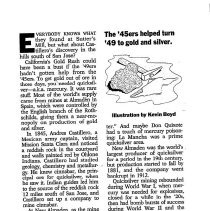Archive Record
Images

Metadata
Catalog number |
1997.2.2158 |
Object Name |
Clipping, Newspaper |
Date |
1985 |
Description |
TITLE: Quicksilver, West Primer SUBTITLE: The '45ers helped turn '49 to gold and silver AUTHOR: Joanne Jacobs PUBLISHER: San Jose Mercury News Everybody knows what they found at Sutter's Mill, but what about Castillero's discovery in the hills south of San Jose? California's Gold Rush could have been a bust if the '49ers hadn't gotten help from the '45ers. To get gold out of ore in those days, you' needed quicksilver-a.k.a. mercury. It was rare stuff. Most of the world's supply came from mines at Almaden in Spain, which were controlled by the English branch of the Rothchilds, giving them a near-monopoly on production of gold and silver. In 1845, Andres Castillero, a Mexican army captain, visited Mission Santa Clara and noticed a reddish rock in the courtyard and walls painted red by Ohlone Indians. Castillero had studied geology, chemistry and metallurgy. He knew cinnabar, the principal ore for quicksilver, when he saw it. Indian guides led him to the source of the reddish rock 12 miles south of San Jose, and Castillero set up a company to mine cinnabar. At New Almaden, as the mine was named, ore was roasted in furnaces; the vapor condensed into quicksilver, which was used to refine Gold Rush gold and Comstock Lode silver. The mine also supplied fulminate of mercury-which makes things go boom-to the Union Army during the Civil War. (Rebs got it from Spain.) Most of the workers were Mexicans, but miners came from all around the world to work in New Almaden. It was dangerous work.` Mercury poisoning, says a turn-of-the-century local history book, "causes the appetite to fail, the digestion to become impaired, the secretions to become thin and copious and the skin to have an earthy paleness." Ore was absorbed through the skin. The Indians were examples of that. The red rock-they called it moketka-was used for ceremonial face paint. Smear on enough moketka and you would have visions of spirits, a spiritual side-effect of nerve damage. Mercury was used in making hats, leading to the expression "mad as a hatter" `The '45ers helped turn '49 to gold and silver. Illustration by Kevin Boyd And maybe Don Quixote had a touch of mercury poisoning: La Mancha was a prime quicksilver area. New Almaden was the world's largest producer of quicksilver for a period in the 19th century, but production started to fall by 1881, and the company went bankrupt in 1912. Quicksilver mining rebounded during World War I, when mercury was needed for explosives, closed for a while in the '20s, then had bomb bursts of success during World War II and the Korean War. New Almaden closed for good in 1975. After producing $50 million of quicksilver over the years, it was tapped out. Now the site of Castillero's find has become Almaden Quicksilver Park. A few relics of the mining days can be glimpsed from hiking trails, but to get a good look at the past, visit the New Almaden Quicksilver Mining Museum, open from noon to 4 on Saturdays. Call the museum at (408) 268-1729 to get a closer look at the mines: Most of the tunnels are off-limits because of worries about mercury poisoning, but one can be entered for about 100 yards. And Castillero? Despite the significance of his discovery, he doesn't take up much space in the history of New Almaden. He sold out to an American a few years after establishing the. mine-and, like Sutter, he never got rich. JOANNE JACOBS is a Mercury News columnist. |
People |
Castillero, Andres |
Pub Place |
New Almaden Mine |
Cataloged by |
Meyer, Bob |
